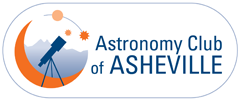Understanding and Choosing Binoculars
What is the right pair of binoculars for you, and what does that “10×50” on the side of the binocular housing mean anyway? Choosing the right pair of night-sky binoculars can be confusing because you have to consider several factors including how steady you can hold them. The links below will help you better understand the factors to consider before making that binocular purchase as well as how to use and adjust your binoculars.
Binoculars Binocular Basics Guide to Choosing Astro-Binoculars
How to Choose a Telescope
The link below will provide you with a well-written article from the folks at Sky & Telescope that is loaded with information about the different types of telescopes, telescope mounts, and decisions to be made in purchasing a telescope.
https://skyandtelescope.org/astronomy-equipment/how-to-choose-a-telescope/
For some wise advice on what to avoid when buying a telescope, see the link below:
https://www.astroasheville.org/wp-content/uploads/2019/10/What-to-Avoid-When-Buying-a-Telescope.pdf
Telescope Mounts and Polar Alignment
A telescope mount is as important as the optical tube itself. So which type of mount should you get? And how do you polar align and operate one of those German equatorial mounts?
The links below are helpful in answering these questions:
Types of Telescope Mounts: https://cosmicpursuits.com/1100/telescope-mounts/
Polar Aligning an Equatorial Mount:
https://skyandtelescope.org/astronomy-resources/accurate-polar-alignment/
How to Use a German Equatorial Mount: http://www.astronomyboy.com/eq/
Selecting Telescope Eyepieces
Although telescopes gather light from the object(s) in its field of view, it’s the eyepiece, not the telescope, that magnifies the image at the focal point! Larger aperture telescopes gather more light.
Determining what eyepiece (ocular lens) to use for a particular celestial object requires a basic knowledge of how to calculate the eyepiece’s power and field of view, as used in your specific telescope. The two documents, linked below, explain those “formulas” and more quite well.
Eyepiece Formulas
More About Selecting Eyepieces
Telescope Image Orientation – Why Is Everything Upside-Down?
Learn why the image in your telescope appears incorrectly oriented and what, if anything you can do about it. Click here.
Using Digital Setting Circles with your Telescope
Digital setting circles (DSCs) make locating celestial objects in the night sky much easier, especially faint objects or when observing in light polluted areas. The Astronomy Club of Asheville presentation below explains just how DSCs work and more.
Collimation of your Telescope Mirrors
Properly aligned optics are important for a crisp view of celestial objects. The two links below provide a good discussion and illustration of the process for a Newtonian Reflector:
https://skyandtelescope.org/astronomy-resources/how-to-align-your-newtonian-reflector-telescope/
https://www.astroasheville.org/wp-content/uploads/2019/03/Newtonian-Collimation.pdf
For a guide to collimating your Newtonian or Schmidt-Cassegrain telescope without tools, see this procedure documented by the folks from Sky & Telescope at the link below:
https://www.astroasheville.org/wp-content/uploads/2013/09/No-Tools-Collimation.pdf
Although there are numerous collimation tools, including laser collimators, the use of a relatively inexpensive “collimation cap” (shown to the right) may be all you need to perform a reasonably precise mirror alignment for your Newtonian reflector. These caps are available from vendors, like the one at the link below:
https://www.cameraconcepts.com/collimation-cap.html
How to Clean Your Optics
Keeping your telescope, binoculars and eyepieces in tip-top condition doesn’t have to be intimidating or time consuming. Below are links to two articles from Sky & Telescope that provide excellent instructions on how to care for your optics.
https://www.astroasheville.org/wp-content/uploads/2014/06/Cleaning-Optics.pdf
https://www.astroasheville.org/wp-content/uploads/2019/03/Cleaning-your-Newtonian-Optics.pdf
An Introduction to the Gear ofAstro-photography
The link below provides a great guide for folks both new to and experienced with astro- photography. This file is a large “pdf” file (10.6 MB) that you may open here and then save to your computer, but it takes a few moments to load.
A Full and Proper Kit (PDF format – 11MB)
CCD Astronomy – Imaging the Deep Sky
Astronomy Club of Asheville member Ken Westall gave this presentation at our December 2011 club meeting. It covers the basics of CCD (charge-coupled device) astronomy imaging: the equipment, the proper set up, and the methods and techniques.
PDF version (4MB)
CCD Astronomy – Automating the Process
Astronomy Club of Asheville member Ken Westall gave this presentation at our January 2014 club meeting. It describes how he automated his CCD astronomy imaging so that he can now sleep while his telescope and camera are busy working through the night!
PDF format (6MB)
Single-Exposure “Deepscape” Imaging
The Sky & Telescope article, linked below, provides some very useful tips on how to capture striking photographs of deep-sky objects above landscapes in a single exposure. The author is a world-renowned nightscape photographer whose beautiful images are widely published.
https://www.astroasheville.org/wp-content/uploads/2019/12/One-Shot-Nightscape-Imaging.pdf

